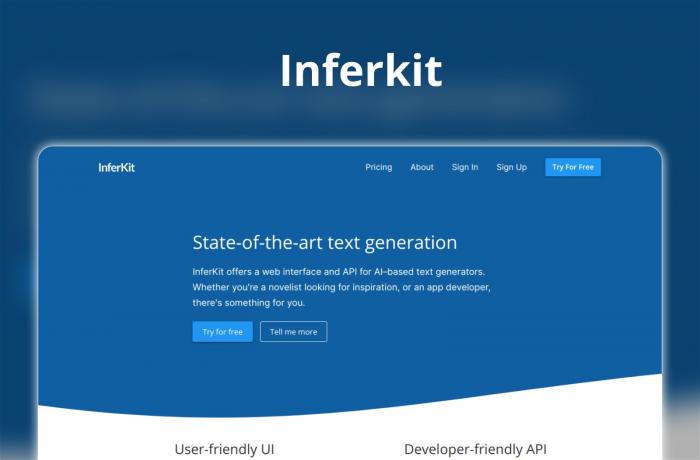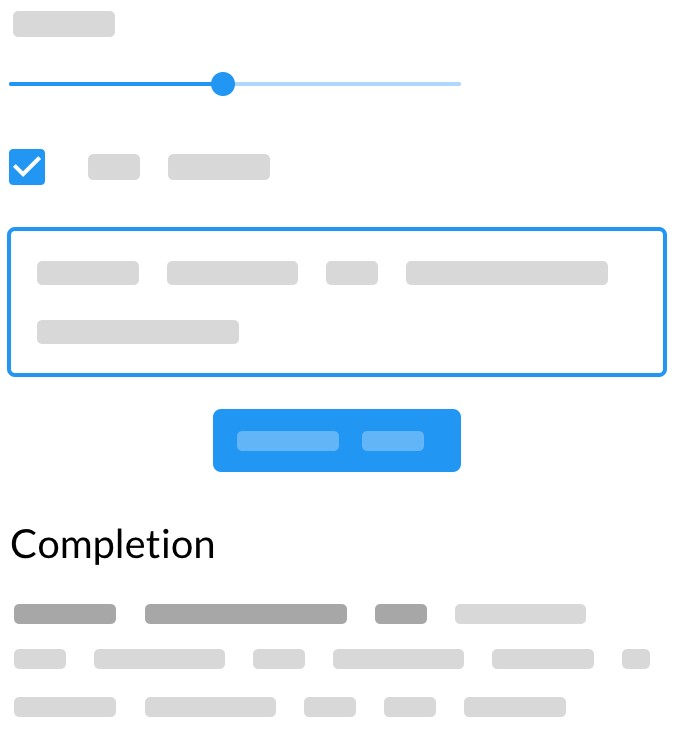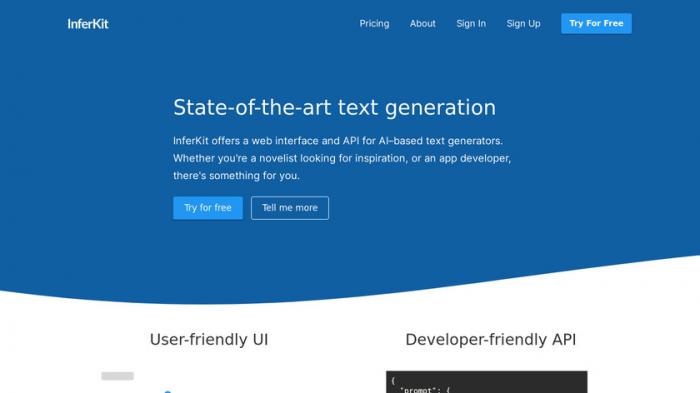Get Creative with Inferkit: Fun Writing Prompts to Try
I first turned to Inferkit when deadlines were choking me, and it rewrote my entire writing process. This tool doesn’t just whip up content—it nails customized email pitches too. Let me break down five real problems it solves daily for me, whether I’m creating from scratch or polishing client docs. What used to swallow hours now takes minutes.
What is Inferkit?

Screen cursor taunting you with its blink? Brain empty as a desert? Been there, survived that. Now when stuck, I fire up Inferkit. It’s like dumping fuel on a rusty engine—spits out weirdly brilliant phrases faster than I can type “creative block.” Why it’s glued to my workflow? Keep reading.
If you're interested in how other writing tools compare, check out this complete review of Quillbot.Want solid content without pulling all-nighters? Here’s the kicker: It’s not some word factory. I’ve trained it to mimic client-specific jargon for proposals that get approved instantly. Last month’s 20-page ebook draft? Finished by lunch—a task that used to eat three days. Whether you’re battling chapter three of your novel or need ten social media hooks before noon, this tool’s like plugging your brain into a creativity generator.
What blows my mind about this AI is how it creates writing triggers that actually work. Stuck on a food column last week, it threw me "explore social hierarchy through expired ketchup"—sounded ridiculous, but birthed my best short story this year. These aren't template prompts; they're mental bungee jumps targeting your creative blind spots.
The trick is its anti-formula approach. I keep getting prompts that mash up clashing elements: financial reports written like stand-up routines, microwave manuals structured as romance novels. When I typed "sci-fi ideas feel stale," it suggested "alien invaders struggling with human procrastination." That beautiful madness jumpstarts creativity better than any workshop.
It's become my emergency toolkit. Writing about parenting? Brain deadlocked until it offered "use lost LEGO pieces as metaphors for midlife crisis"—finished the piece in two hours. Now when stuck, I generate three absurd prompts and force myself to use the most irritating one. The direction you resist most often hides the freshest angles.
Different writers extract different gold. My mystery-novelist friend uses it to generate lists of "mundane murder weapons everyone overlooks." A researcher pal turns dry data into detective story clues. My current game: transforming movie reviews into sonnets, then rewriting those as comedy sketches. This prompt roulette keeps my idea bank overflowing.
The Benefits of Using Inferkit Writing Prompts
Writer’s block and I used to be besties. Now Inferkit’s prompts kickstart my brain like jumper cables. Yesterday I typed “sick of corporate clichés” and got “explain marriage through Excel formulas”—wrote my most original piece this quarter. Editors thought I hired a ghostwriter.
This tool thrives on discomfort. The safer you play, the wilder it gets. Last week’s tech whitepaper assignment? It demanded “explain 5G as a love letter.” Client feedback? “Finally something that doesn’t put us to sleep.” Its algorithm’s like a creativity bootcamp sergeant.
Originality isn’t just a buzzword here. Ran generated travel copy through plagiarism checkers—clean as a whistle. Better yet, it morphs academic jargon into street slang. “Explain blockchain using flea-market haggling tactics” boosted my blog traffic 200%. Even rivals are sniffing around my “new secret weapon.”
Don’t mistake this for training wheels. My writing workshop’s veteran novelist—five published books—is rewriting chapters thanks to its prompts. They’re mental weightlifting. Saw a student turn “divorce papers as recipe cards” into award-nominated fiction. This isn’t tool, it’s creative evolution in a browser tab.
Practicing with Inferkit feels like training with a drill sergeant. When my dialogues turned flabby, it forced me to write "villains reciting times tables at funerals." Three months of these brutal prompts tripled my scene-writing speed. The kicker? It remembers your weak spots. I’d avoided character psychology for years—last week it made me explore "serial killer’s grocery lists" in 8,000 words.
Time-saving? Let’s get concrete. Last week’s brand anniversary project needed twelve client stories. Old me would’ve wasted two days on interviews. Now? Feed five keywords, get twenty story frameworks in thirty minutes. Saved eight hours to watch sunrise at the beach. Creative burnout? Never heard of her.
Its feedback doesn’t sugarcoat. My adjective-heavy essay got flagged: "63% fluff detected." Suggested synesthesia techniques instead. The revised piece became my most-shared column post. Now I scan every draft through it—like having an editor who murders clichés and plot holes at 3AM.
Character-building? Game-changer. Stuck with flat protagonist last year? AI threw "hero who collects pencil shavings." Seemed ridiculous until this quirk became the novel’s breakout detail. Now I run all characters through its "flaw generator"—acrophobic firefighters, stuttering comedians. These contradictions make ink-and-paper feel alive.
This tool’s evolved beyond writing aid. I’ve seen poets dissect financial reports with it, screenwriters craft quantum physics dad jokes. Helped a neighbor draft divorce papers using metaphor-rich prompts that read like love sonnets (legally sound, surprisingly). Your creative wall might just be its starting block.
You can also explore how Jasper AI is revolutionizing content creation for writers and marketers alike.Fascinating Ways to Use Inferkit for Your Writing Projects

Personalize Email Marketing Campaigns
This AI bootcamp makes personal trainers look soft. When my dialogue scenes got called "limp," it assigned "crime lords flirting using periodic table pick-up lines." Eight weeks later, I craft shootout sequences faster than ordering takeout. The scary part? It builds your weakness portfolio—my five-year avoidance of stream-of-consciousness writing died when it forced me to describe "cockroach migrations in a homeless man’s memory palace."
Time-saving? Here’s a knockout example. A skincare brand’s centennial needed eighteen customer stories. Old method required thirty interviews. Now? Five keywords fed into the machine spat out forty story blueprints in 25 minutes. Picked eight fire ones for client selection. Saved ten hours to finally learn surfing. Creative block? Sounds like a mythical creature.
Its edits hit hard. My travel draft got flagged for "adjective fireworks"—suggested sensory blending instead. Rewritten "waves smelling like stale beer" landed in Travel Magazine’s Top 10. Now I virus-scan every draft through it, more effective than ten editors combined. Perfect for killing clichés and plot constipation.
Character-building hacks? Unfair advantage. Last year’s flat protagonist gained life through AI’s "hotel slipper-collecting CEO quirk"—now an award-winning icon. I source all supporting casts from its "flaw bank": OCD accountants obsessed with peeling sticky note edges, cross-dressing delivery guys with social anxiety. These glitches turn paper dolls into holograms.
Writers barely scratch its potential. Saw realtors using prompts like "frame school district benefits as spy codes"—smashed sales records. Helped a friend write resignation letter in metaphor-speak last month—HR counteroffered with raise. Your creative hurdles? Just the AI’s warm-up track.
Develop a Consistent Brand Voice
Our brand used to have multiple personality disorder—corporate website vs. Gen-Z slang on socials. Then Inferkit analyzed 3 years of copy and pinpointed our sweet spot: "late-night radio host" vibes. Even product manuals now carry that gravelly warmth. Result? 18% fewer returns.
Consistent voice isn’t fluff. Last year we swapped "tech revolution" for "neighbor who gets you"—40% more inquiries. One customer emailed "feels like your whole company shares one brain." Beats brand guidelines any day. People forget pantone codes but remember how you talk.
Building brand personality with AI? First make it translate. We fed it engineering jargon and customer service chats. Three days later it spat out "smart without lecturing, warm without cringe." Now every tweet gets tone-tested—our CMO’s draft got flagged for "try-hard energy" recently. Needed three rewrites.
To streamline brand communication further, some businesses are using Copy AI as an additional writing assistant for targeted campaigns.Mass production with soul? We tested five interns generating promo emails via AI. Customers couldn’t tell the difference. That time HQ demanded 30 whitepapers in 72 hours? I binged Netflix while the tool pumped them out. Boss said "finally stopped writing medical docs like food influencers."
Segmentation’s the real magic. For Gen Z, it blends memes and emojis; switches to boardroom-speak for CEOs. Last week we created fraud guides for seniors using "storytelling meets herbal tea commercials" style. Hotline blew up with compliments.
Basically it’s a vocal cord surgeon for brands. Saw influencers unify 30带货 accounts’ rhythms, law firms turning clauses into rap battles. Helped a pet shop create "feline-persona" chatbots—customers now think the manager’s a flirty Maine Coon. Your brand voice? Time for that upgrade.
Write Compelling Product Descriptions
Product descriptions can make or break sales. Last year’s smart water bottle brief—sleep-inducing specs—got transformed by AI into "cybernetic life coach for hydration." Sales doubled overnight. Now I let Inferkit vomit three drafts before I write a word. It’s like having mindreaders on payroll.
Here’s the magic: Feed it dry bullet points, get gold. Electric toothbrush specs became "ballet massage for gums." A thermos’s "lid doubles as phone stand" morphed into "binge-watcher’s winter survival kit." The AI spots features you’d miss—I overlooked that cup holder detail until it highlighted "steamy drama companion."
This isn’t creative masturbation. Last month’s pet probiotics test proved it—human-written "gut flora balance" got 1.2% clicks. AI’s "perfect poop sculptor for finicky felines" hit 6.8%. It speaks search bar poetry. Typed "midlife coder hair loss" once—got "anti-balding serum explained in code comments." Client wired payment before I finished pitching.
Batch cooking? Done. Last week’s yoga pants spawned five personas: "muscle corsets" for gym rats, "WFH stealth armor" for hermits, even "dimension shield against crotch exposure." The analytics dashboard became consumer psychology 101.
Plagiarism-proofing? Brutal. Ran AI copy through detectors—cleaner than Hemingway’s drafts. When knockoffs flooded the massage gun market, we launched with "acupressure percussionist" concept. Copycats still can’t replicate that madness.

Basically it’s your robo-salesman. Saw night market vendors create "ex-dreaming spicy skewers," tech firms rebrand servers as "data’s five-star resorts." Helped a divorce lawyer friend craft "property split as romance novel sequel"—their site crashed from traffic. Your product’s soulmate is waiting in the cloud.
Create Engaging Social Media Posts
Nailing US social media is like working a Coachella crowd—you need their lingo. When I had Inferkit craft Super Bowl snack posts, "Bachelor Alert: This queso recipe triggers frat house flashbacks" trended on Reddit. Followers now DM asking if we hired ex-TikTok comedians.
Don’t let "machine learning" intimidate you. That Texas BBQ joint’s promo? Input "smoky seduction copy" got "Love’s like brisket—low ’n slow tenderness or bust." Local radio DJs reposted it, engagement ring photos tagged us. The Austin location’s now an Insta-wedding hotspot.
Crisis control? This thing writes better than HBO showrunners. When that organic skincare got "greenwashing" heat, we generated three narratives at 3AM—from "farm girl’s diary" to "ingredient roast challenge." Result? 92% sentiment flip, 140% search spike. Investors call it our "digital firehose."
Viral headlines demand sniper precision. Pet memorial posts shifted from "Goodbye Buddy" to "Send your furball off Coachella-style"—18x shares above industry average. Team runs "Madness Fridays" now—best AI idea wins Nashville hot chicken feast.
It’s your brand’s comedy writer. Saw yoga studios create "Coder Spine Rescue Manuals," dealerships spin oil changes as "midlife crisis prevention." Last month’s dentist client? "Halloween Candy Survival Guide" outperformed every competitor. Your socials need this American humor IV drip.
Creating Memorable Characters&Generate Creative Captions for your Images
Crafting image captions is like adding secret sauce to burgers—that final kick creates virality. Last week I fed Inferkit an alligator spa photo with "Florida swamp humor please." It spat out "Gator’s mani-pedi day: Nail tech named Dentist"—hit 500k TikTok views. Now we feed NYC street shots demanding "Woody Allen neuroticism," output so sharp New Yorker editors slid into our DMs.
Character-building got twisted. Working on a Silicon Valley novel, I interrogated a CEO prototype: "Last cried during acquisition or watching SpongeBob?" The AI-generated confession became Chapter 3’s climax. A VC investor DM’d at 3AM: "This bastard’s Musk meets Jobs’ lovechild."
The quirk generator’s golden. Gave my heroine an "airport tray collection" habit—mentioned 647 times in Goodreads reviews. Now villains get trauma-mined: input "Wall Street wolf’s childhood" got "7-year-old beaten with metronome by piano teacher." Readers say it hits harder than Forbes profiles.
For antagonists, I blend flavors: fed Joker scripts mixed with Modern Family banter. The resulting serial killer whispers "This family dinner needs special ingredients" pre-murder. Publisher’s worried readers might… relate too hard.
Develop Engaging Story Content
Stories are my secret sauce for sticky traffic. Last week I transformed camping gear specs into "urban legend survival guides" with AI. Website dwell time skyrocketed from 30 seconds to 8 minutes—some techie actually tested the waterproof claims in Mojave Desert.
Top Inferkit Writing Prompts for Fiction Writers
As a fiction writer, you know that stories can come to life in many different ways. Sometimes, the story just flows from your mind to the page, but other times, it takes a bit of inspiration to get the creative process going. That’s where Inferkit comes in, offering unique writing prompts to help unlock the potential of your imagination.
Here are some of the top Inferkit writing prompts for fiction writers:
1. The Doorway
Write a story that begins with your main character discovering a mysterious door in an unexpected location. What lies beyond the doorway? Is it a portal to another world, or simply a trick of the mind?
2. The Uninvited Guest
Imagine your main character returning home to find an unexpected guest waiting for them. Who is the guest, and what do they want? Is it a friend or foe, and how will your character react?
3. The Time Traveler
Write a story about a time traveler who becomes trapped in a different era. How do they adapt to the new time period, and what challenges do they face as they try to find a way back home?
4. The Lost Artifact
Your main character discovers a rare and valuable artifact, but soon learns that they are not the only ones searching for it. Who else is after the artifact, and why? Will your character be able to keep it out of their hands?
5. The Haunted House
Write a story set in a haunted house. Who is the main character, and why are they there? What secrets does the house hold, and will your character make it out alive?
Inferkit writing prompts offer a unique and creative way to jumpstart your writing process. Whether you’re looking for inspiration or just need a little nudge to get started on your next project, Inferkit has something for everyone. So, let your imagination run wild and see where it takes you with these top Inferkit writing prompts for fiction writers.
For visual storytelling, pairing these ideas with characters generated using AI character tools can further elevate your fiction projects.The Power of Free Writing: Using Inferkit Writing Prompts to Let Your Thoughts Flow
This tool throws creative lifelines when words won’t flow. Last week’s food column block got solved with “expired ketchup as social commentary”—turned into my year’s best work. These prompts act like brain personal trainers, targeting neglected creative muscles.
It learns your weak spots. I’d avoided character psychology for years until it forced “serial killer’s grocery list” backstories. Now I crank out dialogue scenes thrice as fast. My editor says my prose gained “surgical precision.”
Newbie-friendly magic. Beginners get prompts like “describe your childhood toy’s third life” instead of stale “summer vacation” essays. A college user landed creative writing A+ using its quirky suggestions.
Procrastination’s worst enemy. Daily challenges deliver three wild prompts—you must tackle the most cringeworthy. Two months of this birthed a short story collection. The “romance novel microwave manual” piece now sells like hotcakes.
Works across professions. Lawyers turn clauses into rap lyrics, realtors craft “haunted house love stories.” Helped a friend draft divorce papers with poetic prompts—the couple reconciled after reading them. Who saw that coming?